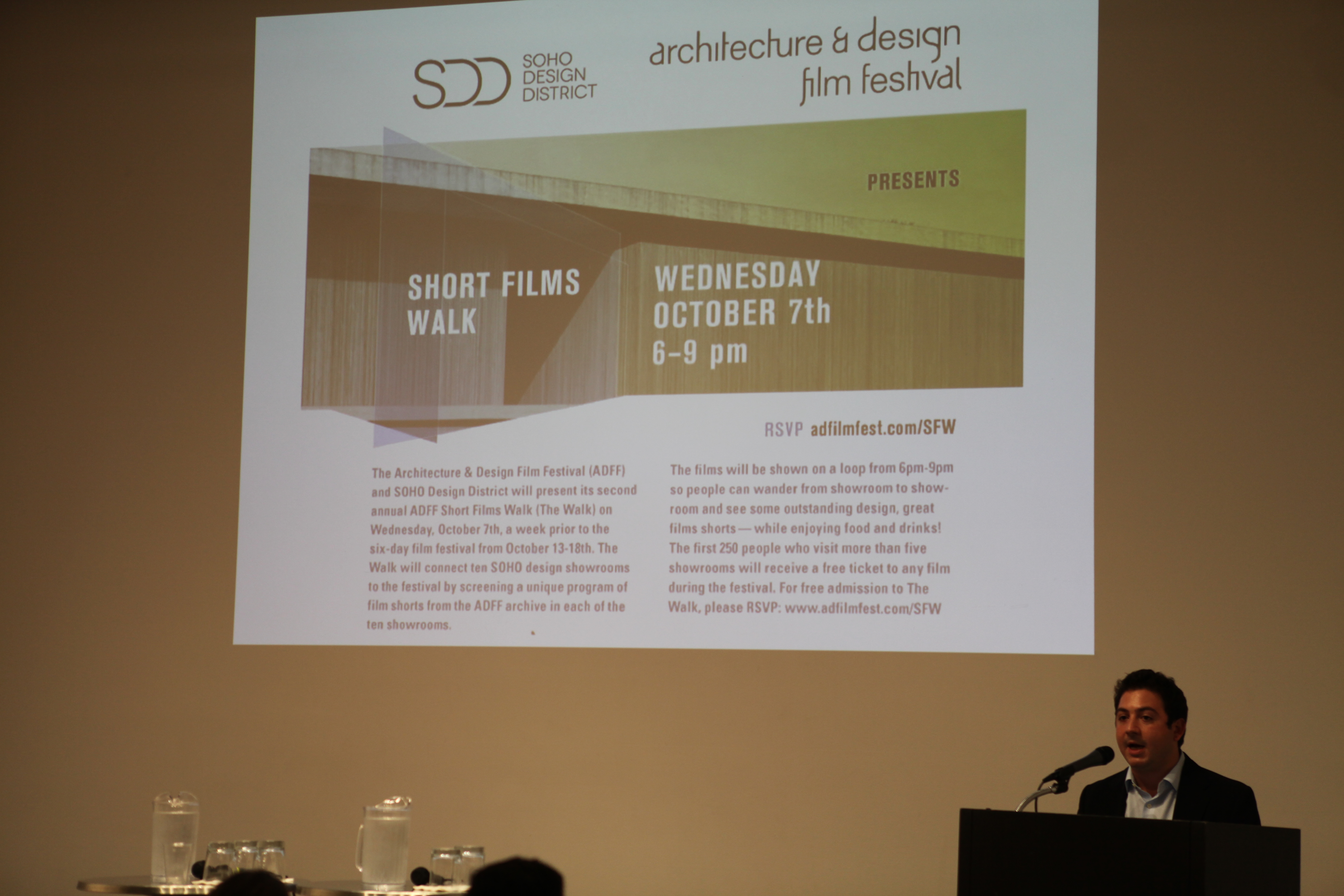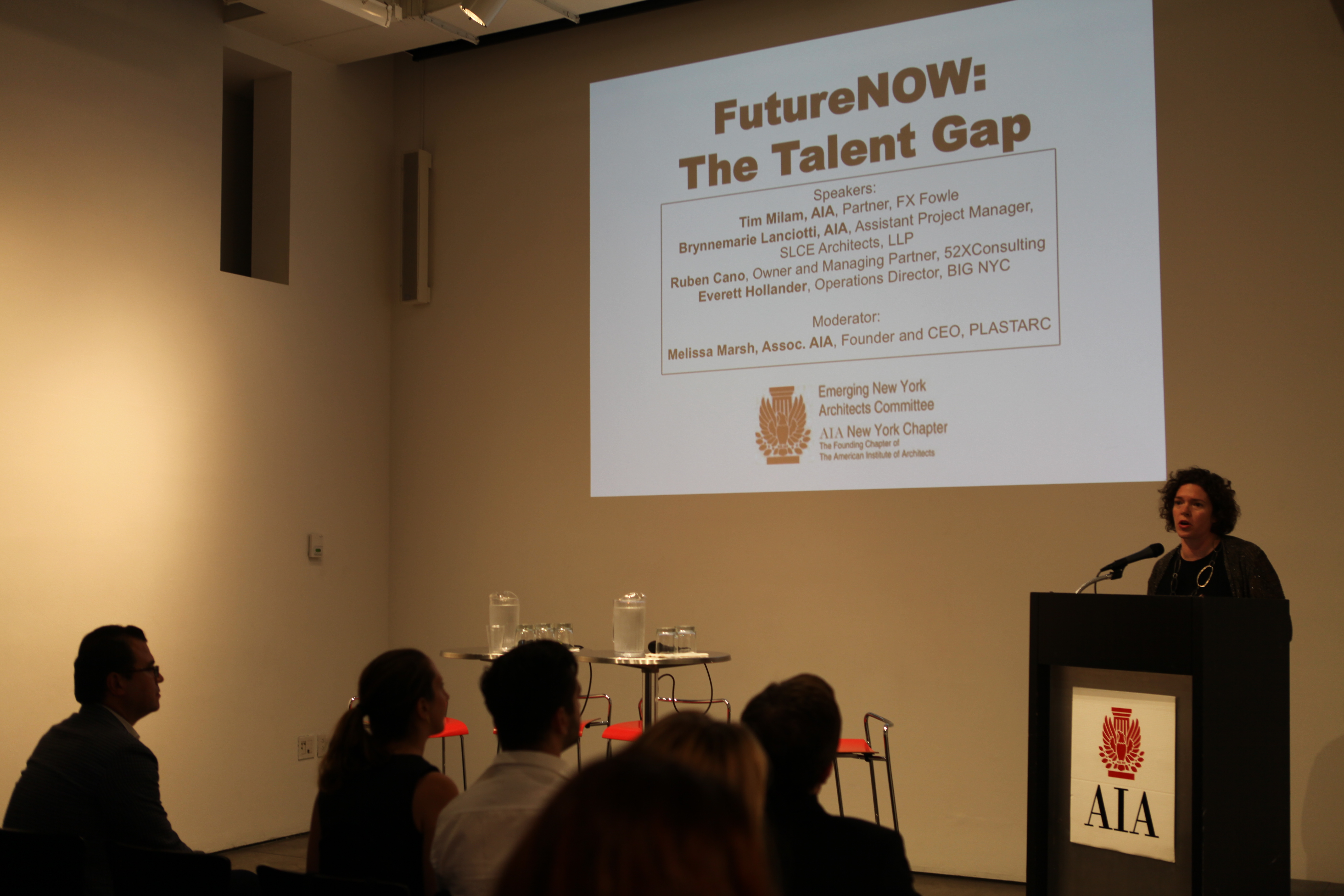by: Claire Rowell
On Archtober Eve at the Center for Architecture, firm leaders and young talent filled Tafel Hall with exciting conversations about an architectural landscape where these two groups engage and learn from one another to shift hierarchies, people strategies, and core competencies within the profession. A collaboration between the Emerging New York Architects (ENYA) and the Professional Practice Committee, FutureNow: The Talent Gap attracted an audience representing two constituencies: talented, excitingly disruptive young professionals and established practitioners and principals. The program sought to enable a desperately needed conversation between the two. Today, the industry is poised to apply lessons learned from the post-recession talent-gap years to define a new future, new expectations, and new standards for talent, people, and policy.
The talent gap in the architectural industry is defined as the lack of professionals with – five to six years of experience. Due to the recession-caused hiring freeze, those who do hold the design, technology, and business skills are industry-acclaimed ”unicorns.” While some have drifted to different industries, others have been challenged to fill their own professional gaps in more creative ways. All in all, the industry finds itself lacking a ready and able strata of professionals with the hybrid leadership, business, and architectural skills to step up to the plate. The evening delved into the story of the post-recession era, and provided lessons and insights from those who are approaching the talent gap in diverse ways. They discussed what is needed to attract and retain top talent, and how individuals and firms can support more effective and fulfilling career paths to future-proof the profession’s product, talent, hiring model, and skill sets.
Ruben Cano of 52x Consulting, a recruiting firm focused on placing talent in the A/E/C industry, stressed the importance of diversifying your professional skill sets to stay relevant, valuable, and positioned for long-term career growth. From technology to business to, most importantly, people skills, Cano’s impressive industry evaluation highlighted the financial rewards and upward trajectory of architects who can prove their business and people relationship savvy. With faster production technologies, software evolutions, and changes in aesthetic trends, the half-life of some skills is decreasing. Luckily, some things never lose value; namely, who you know and what business you can build with your connections. While technical capabilities may wane over time, there are myriad other skills that make up a professional skill set, and architectural education should incorporate the lesson that purely technical skills are not enough to sustain a successful career.
Brynnemarie Lanciotti, AIA, a young architect, described the personal and professional challenges associated with charting an “above average” career in the profession amidst the challenges of the recession. Her professional trajectory underlined the lessons from Cano’s insights with two words of wisdom to emerging talent: focus on finding supportive professional networks; and develop a variety of business skills in supportive environments. She became involved with the ENYA community during the recession, and stressed the importance of professional organizations in building community, connections, skill sets, and even leadership experience. She was also fortunate to start her career as a practitioner in a small and supportive firm. Recognizing issues likely to be on the minds of many women and young professionals, Lanciotti addressed career trajectory in relationship to those of senior leadership at their own firms, referencing the conundrum of one’s career advancing past the principals in charge. Regardless, the value of a supportive firm that prioritizes professional development in their emerging talent was indispensable to Lanciotti’s growth, ingraining important business skills and accelerating her learning through close engagement with clients and the firm’s leadership team.
Everett Hollander, operations director at BIG – Bjarke Ingels Group NYC, showed how BIG brings together the feel of a Silicon Valley high-tech start-up with East Coast “capital A” architecture. Staff doesn’t take off on Friday afternoons so that partners can go to to Hudson and the Hamptons. Instead, the whole team goes on week-long study tours to Copenhagen. Together, Hollander’s photos of technicolor slumber parties, mountain ascents, client pitches, and prized models put the captivating features of the non-hierarchical architecture firm into relief. BIG’s success has been, in part, driven by a new generation of client organizations that have been attracted to a shared view of organizational design, company culture, and business practices. This brings to mind a pre-industrialized version of a studio, leveraging its collective talent for the good of all and for the benefit of its greatest contributors. It may seem like a dream, but BIG is real. Hollander represents an emergent trend; though trained in traditional architecture, he practices ”business architecture,” building on his skills in the profession and applying them to challenging and changing the business strategy, brand, and experience of how, why, and where architects practice.
Tim Milam, AIA, partner and managing director at FXFOWLE, brought us back to reality with a thoughtful and well-executed presentation. In addition to his usual role, Milam was blessed with the unique opportunity to act as Head of Talent while the firm’s HR business partner was on maternity leave. This experience left him with the realization that any organization will advance if you ask more questions, and experiment with the connections between HR and marketing. Furthermore, the intersection of marketing and HR is key to building a strong brand experience for not just your clients, but for future talent, a lesson learned from technology and other industries. Bridging HR, knowledge management, and the partners who “own” these areas enables connection between senior management and young professionals, two groups that have a lot to learn from one another to close the talent gap and move the industry forward.
Moderator Melissa Marsh, founder and CEO of PLASTARC, made a plea to the audience: academia and professional organizations must better enable business capabilities in architectural curricula and continuing education, early and often (a mission that Marsh additionally champions as curator of the Transforming Architectural Practice series). In a field rife with brilliant designers, how can the architectural industry leverage the skills of the profession amidst two impending scenarios? First, an architectural diaspora that sees trained architects leaving for more profitable design and technology sectors, or second, a devaluation and outsourcing of architectural skill sets to project management and real estate firms? The good news is that data and information on everything from trends in architectural hiring, to design skills valuation, to company culture ratings are available on HR websites like Glassdoor. To young architectural professionals looking to ensure a future without a talent gap: leverage data; demand greater professional practice courses in your education; and continuously seek out professional development and mentoring opportunities within your firm and beyond.
Event: FutureNOW: The Talent Gap
Location: Center for Architecture, 90.30.15
Speakers: Tim Milam, AIA, Partner, FXFOWLE; Brynnemarie Lanciotti, AIA, Assistant Project Manager, SLCE Architects; Ruben Cano, Owner and Managing Partner, 52XConsulting; Everett Hollander, Operations Director, BIG – Bjarke Ingels Group; Melissa Marsh, Assoc. AIA, Founder and CEO, PLASTARC (moderator)
Organized by: AIANY Emerging New York Architects












